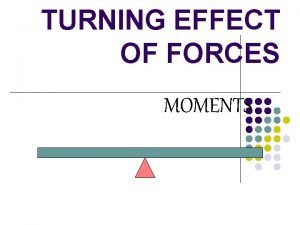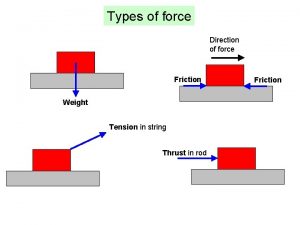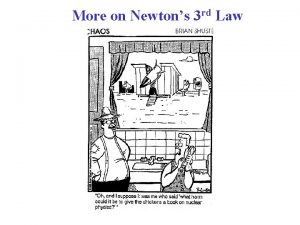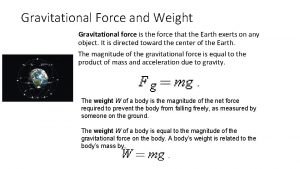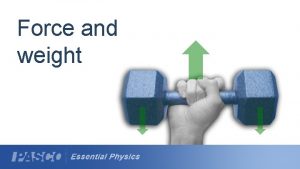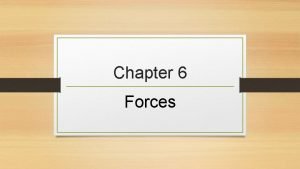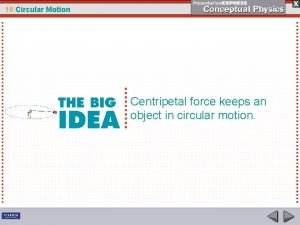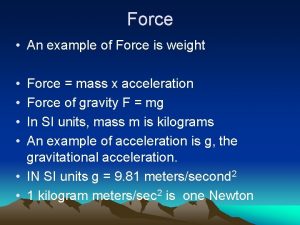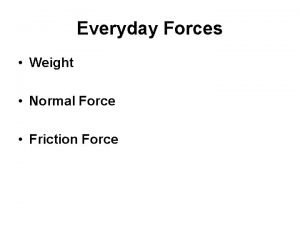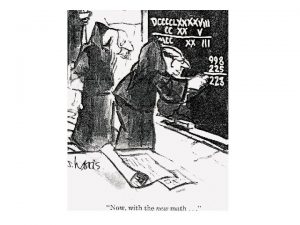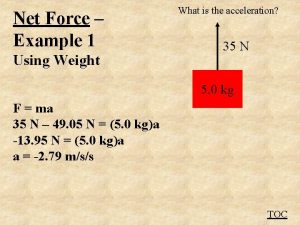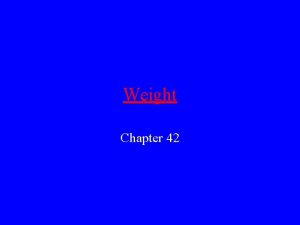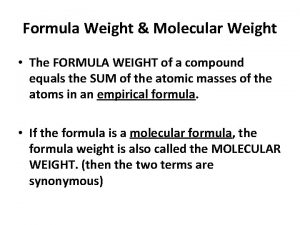Net Force Example 1 Using Weight What is













- Slides: 13

Net Force – Example 1 Using Weight What is the acceleration? 35 N 5. 0 kg F = ma 35 N – 49. 05 N = (5. 0 kg)a -13. 95 N = (5. 0 kg)a a = -2. 79 m/s/s TOC

What is the force? Net Force – Example 2 F=? Using Weight F = ma F – 78. 48 N = (8. 0 kg)(+3. 5 m/s/s) F = 106. 48 N 8. 0 kg (Accelerating upwards at 3. 5 m/s/s) TOC

Whiteboards: Using Weight 1|2|3|4|5 TOC

Find the acceleration: F = ma, weight = (8. 0 kg)(9. 81 N/kg) = 78. 48 N down Making up + <100. N - 78. 48> = (8. 0 kg)a 21. 52 N = (8. 0 kg)a a = 2. 69 m/s/s +2. 69 m/s/s 100. N 8. 00 kg W

Find the acceleration: F = ma, wt = (15. 0 kg)(9. 81 N/kg) = 147. 15 N down <120. N – 147. 15 N> = (15. 0 kg)a -27. 15 N = (15. 0 kg)a a = -1. 81 m/s/s It accelerates down -1. 81 m/s/s 120. N 15. 0 kg W

Find the force: F = ma, wt = (16 kg)(9. 81 N/kg) = 156. 96 N down <F – 156. 96 N> = (16. 0 kg)(+1. 5 m/s/s) F – 156. 96 N = 24 N F = 180. 96 N ≈ 180 N F 16 kg a = 1. 5 m/s/s (upward) +180 N W

Find the force: F = ma, wt = 1177. 2 N downward <F – 1177. 2 N> = (120. kg)(-4. 50 m/s/s) F – 1177. 2 N = -540 N F = 637. 2 N ≈ 637 N F 120. kg a = -4. 50 m/s/s (DOWNWARD) +637 N W

This box is going downwards at 22. 0 m/s and is stopped in a distance of 1. 85 m. What must be the upwards force acting on it to stop it? First, suvat: s = -1. 85 m, u = -22. 0 m/s, v = 0, a = ? use v 2 = u 2 + 2 as, a = +130. 81 m/s/s F = ma, wt = 1177. 2 N downward <F – 1177. 2 N> = (120. kg)(+130. 81 m/s/s) F – 1177. 2 N = 15697 N F = 16874. 5 ≈ 16, 900 N +16, 900 N F 120. kg W

If this box is initially at rest, what is its displacement in 5. 00 seconds? 14. 0 N 2. 10 kg -39. 3 m W

A falling 52. 0 kg rock climber hits the end of the rope going 13. 5 m/s, and is stopped in a distance of 4. 20 m. What was the average force exerted to stop them? F = ma, a = +21. 696 m/s/s (from kinematics) wt = 510. 12 N downward <F – 510. 12 N> = (52. 0 kg)(+21. 696 m/s/s) F = 1638. 3 N +1640 N F 52. 0 kg W

A 65. 0 kg dumbwaiter is going up at 5. 80 m/s and is brought to rest in a distance of 1. 90 m What is the tension in the cable supporting it as it is stopping? F = ma, a = -8. 853 m/s/s (from kinematics) wt = 637. 65 downward <F – 637. 65 N> = (65. 0 kg)(-8. 853 m/s/s) F = 62. 23 N +62. 2 N F 65. 0 kg W

Find the force: F = ma, wt = 1176 N downward <F – 1177. 2 N> = (120. kg)(-4. 50 m/s/s) F – 1177. 2 N = -540 N F = 637. 2 N • Relationship between tension, weight and acceleration • Accelerating up = more than weight (demo, elevators) • Accelerating down = less than weight (demo, elevators, acceleration vs velocity) • Climbing ropes F 120. kg a = -4. 50 m/s/s (DOWNWARD) W

Find the mass: F = ma, wt = m(9. 81 m/s/s) downward <13. 6 – m(9. 81 m/s/s)> = m(-1. 12 m/s/s) 13. 6 N = m(9. 81 m/s/s) - m(1. 12 m/s/s) 13. 6 N = m(9. 81 m/s/s-1. 12 m/s/s) 13. 6 N = m(8. 69 m/s/s) m = 1. 565017261 kg ≈ 1. 57 kg 13. 6 N m a = 1. 12 m/s/s (downward) 1. 57 kg W
 Tolerable weight
Tolerable weight What is an example of bulk gaining industry
What is an example of bulk gaining industry Turning effect of forces examples
Turning effect of forces examples Direction of weight
Direction of weight Is normal force always equal to weight
Is normal force always equal to weight Four forces
Four forces Difference between force and weight
Difference between force and weight Specific gravity to specific volume
Specific gravity to specific volume Is tension contact or noncontact
Is tension contact or noncontact What force provides centripetal force
What force provides centripetal force Contact vs long range force
Contact vs long range force What force provides centripetal force
What force provides centripetal force How does mechanical advantage work
How does mechanical advantage work What is net force
What is net force


